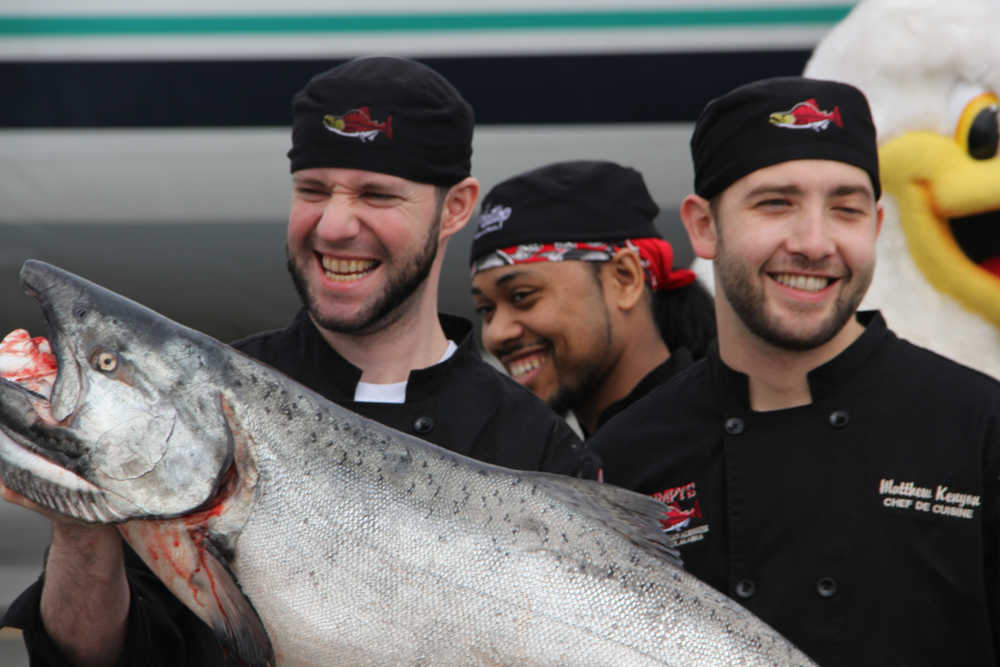A new market analysis has an optimistic outlook for the 2016 salmon season — and goes a long way in explaining why Bristol Bay sockeye salmon received a low dockside price for last year’s catch.
Juneau-based economics firm McDowell Group completed the report under contract from the Alaska Seafood Marketing Institute. ASMI is a state- and private-funded marketing organization specifically set up to increase the foreign and domestic demand and prices for Alaska’s seafood.
ASMI’s report responds in part to fishermen’s concerns about salmon prices paid to fishermen by processors, called the ex-vessel price.
In 2015, fishermen in the state’s most valuable fishery, Bristol Bay’s sockeye salmon, only received half their usual ex-vessel price for fish while the processing and retail industries appeared to maintain their prices.
The report says processors simply had less capital to spread to fishermen in 2015, as they were beset by a host of negative market factors. Strong U.S. currency values lessened purchasing power for key foreign export markets, important export markets vanished, and massive supply caused led to a decrease in overall value.
Combined with 2013 and 2014, two of the largest volume years on record for statewide salmon harvest, last summer’s harvest created downward market pressure as processors were left with an oversupply.
Researchers have a hard time gathering as much first wholesale data as they can with ex-vessel value data. Net processing revenue, they say, makes for the best widely available data to analyze processors’ financials.
Even though wholesale price and corresponding retail prices may not have seemed to vary along with the ex-vessel price, total processing revenue for 2015 was very low. Ex-vessel prices dropped to control costs.
“Net processing revenue averaged $706 million in 2013 and 2014 (about 10 percent below the previous three-year average), and net processing revenue per pound dropped 21 percent (inflation-adjusted basis),” the report reads. “This left many processors in a relatively poor financial position heading into 2015. With less working capital, a large 2015 salmon forecast, mounting canned inventories, and a declining wholesale market, processors were far more conservative with ex-vessel price commitments in 2015.”
The report details that the 2015 ex-vessel price of 50 cents per pound is only the latest in a series of annual price drops. Ex-vessel value for Alaska salmon has declined sharply since 2013, when economists adjusted prices for inflation.
“Ex-vessel value fell by approximately 41 percent between 2013 and 2015 – years which produced the two largest Alaska salmon harvest volumes on record,” explains the report.
“Ex-vessel prices fell for all five salmon species during this time: sockeye (-61 percent), pinks (-51 percent), coho (-45 percent), chinook (-19 percent), and chum (-17 percent).”
Dockside prices reached a peak in 2013 not seen since 1995. In 2013, the total inflation-adjusted value of Alaska salmon was more than $750 million, a level only reached twice in the last 20 years.
The McDowell Group believes prices will stabilize this year, as supply will shrink.
“There are several reasons to be cautiously optimistic that prices for most key products/species will at least stabilize and likely rise somewhat in both ex-vessel and wholesale market,” according to the report. “However, even if prices do increase somewhat, the smaller expected harvest in 2016 will probably result in a lower overall resource value.”
This year, both pinks and reds are set to decline in production. Chinook and coho salmon will increase, but processors rely far more on reds and pinks. Together, the two species make up 84 percent of salmon volume and 78 percent of salmon value.
According to the Alaska Department of Fish and Game, the sockeye salmon harvest — which makes up 55 percent of the state’s salmon sales by value — is expected to be about 7.3 million fewer than in 2015.
ADFG forecasts the Bristol Bay sockeye harvest — the most valuable in the state — to be 29.5 million, far less than the 2015 harvest of more than 36 million but still greater than the 20-year average of 23.2 million.
Both reds and pinks contributed last year to one of the largest overall salmon harvests on record. Statewide, the commercial salmon harvest of all species was 247 million fish, greater than the 2015 harvest projection of 220 million and the 2005-14 average of 179 million fish. The harvest was the second highest since 1994, following only 2013, when the harvest was 273 million fish.
The projected harvest of pink salmon — which run strong every other year — is about 100 million fewer than in 2015 at 190.5 million.
In Prince William Sound where pink salmon is the major harvest, the forecast is 23.4 million, less than average and a change of pace from the 2015 season that broke the 20-year record for the largest harvest with 96 million fish.
Southeast Alaska will have a harvest of 34 million pinks. In Kodiak, 16.2 million is projected, and 13.4 million is forecast for the South Peninsula and Aleutian Islands.
Chile’s farmed salmon situation should also benefit Alaska fishermen as the nation’s large farmed salmon export industry is beset by environmental damage and protests.
Chile is the world’s second largest farmer of salmon, and one of the three main exporters of farmed salmon into the U.S. market along with Norway and Canada.
In 2016, a massive red algal bloom killed upwards of 100,000 tons of Chilean Atlantic and coho salmon stocks — between 12 and 17 percent of the total output, according to various reports — representing tens of millions of dollars of lost product.
The massive supply loss came with a price spike of upwards of 65 cents per pound, according to seafood industry news source Intrafish.
Bristol Bay sockeye fishermen, who compete directly with Chilean farmed salmon, say the price spike should make Alaska exports that much easier both in domestic and foreign markets.
DJ Summers can be reached at daniel.summers@alaskajournal.com.

